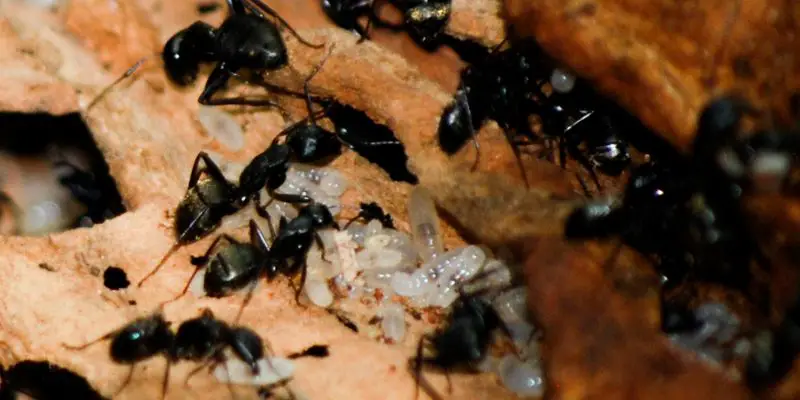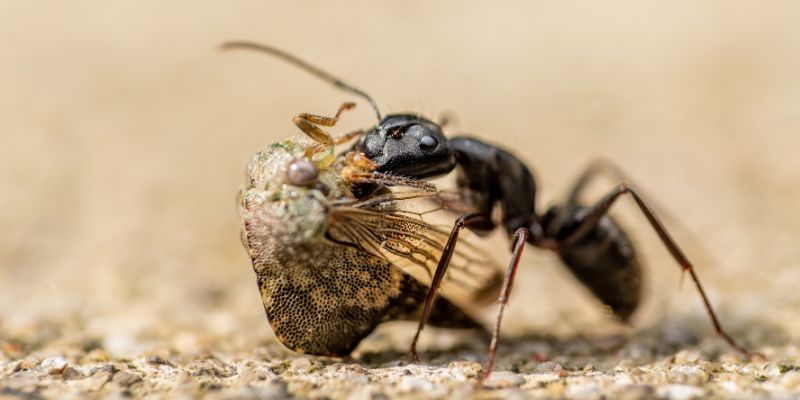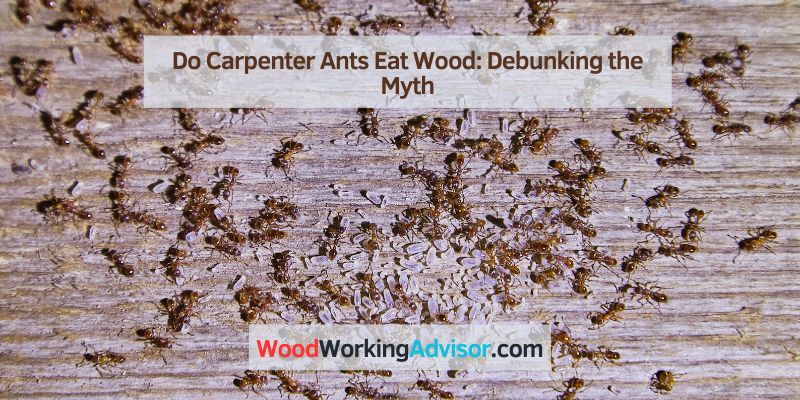Yes, Carpenter ants do eat wood. They tunnel through wood to build nests and may cause damage to wooden structures in the process.
Carpenter ants are a species of ant known for their wood-damaging behavior. These large ants do not actually consume wood for sustenance, but they excavate it to create nests. They typically prefer damp or decaying wood, but can also infest sound wood.
As they create elaborate tunnel systems, they can weaken the structural integrity of the wood. Identifying and addressing Carpenter ant infestations promptly is crucial to prevent significant damage to wooden structures. Understanding their behavior and feeding habits can help in implementing effective pest control measures to protect properties from potential harm.
Carpenter Ants Misconceptions
There is a common misconception that carpenter ants eat wood, which has perpetuated in the public domain over the years, leading to widespread misinformation. It is crucial to address this fallacy and provide accurate information about the behavior of carpenter ants to dispel these misconceptions.
The Common Myth About Carpenter Ants Eating Wood
One of the prevailing misconceptions about carpenter ants is their purported habit of consuming wood as a food source. While it is true that carpenter ants nest in wood, they do not actually consume it for sustenance. Instead, they excavate galleries and tunnels within the wood to create their nests, which can cause structural damage to buildings but does not serve as a food source for the ants.
How Misinformation Spreads And Persists In The Public Domain
Misinformation about carpenter ants and their wood-eating habits spreads through various channels, including word of mouth, inaccurate media portrayals, and misconstrued information on the internet. Once these misconceptions take hold, they can persist due to the lack of clear and accessible sources of accurate information.

Do Carpenter Ants Eat Wood : Debunking The Myth
Carpenter ants are often associated with wood destruction, but do they really eat wood? It’s time to debunk the myth and uncover the truth about these fascinating insects and their relationship with wooden structures.
Examining What Carpenter Ants Really Do To Wood
Contrary to popular belief, carpenter ants do not consume wood. Instead, they excavate galleries within wooden structures to create nests. The primary purpose of this activity is to establish a suitable habitat for their colonies. As they construct their nests, they remove wood fragments, which can often cause damage to the wooden material.
These ants are particularly attracted to moist or decaying wood, making them a potential threat to homes and other wooden structures. It’s important to recognize that while they don’t eat wood, their nesting behavior can still result in significant damage over time.
The Truth Behind Their Relationship With Wooden Structures
Carpenter ants’ interaction with wood is more about creating a conducive environment for their colonies rather than a source of sustenance. Their presence in wooden structures can be indicative of underlying moisture issues or pre-existing wood decay. Understanding this relationship is crucial for effectively addressing carpenter ant infestations and preventing further damage to wooden materials.
Identifying Carpenter Ant Damage
Distinguishing Between Eating And Tunneling
Carpenter ants are often mistakenly thought to eat wood. In reality, they do not feed on wood but excavate it to create galleries for nesting. Distinguishing between the two activities is crucial in identifying carpenter ant damage. While eating wood leaves behind a powdery appearance, tunneling results in smooth, clean tunnels within the wood.
Signs Of Carpenter Ant Infestations In Wood
Carpenter ant infestations in wood can cause significant structural damage if left unaddressed. Identifying the signs of infestation is essential in implementing effective control measures. Some common signs include:
- Frass: Sawdust-like material, known as frass, accumulated near the nest site.
- Hollow sound: Tapping on wood reveals a hollow sound, indicating internal damage caused by carpenter ants.
- Presence of ants: Observing large black or reddish ants, particularly during spring and summer, near wooden structures.
The Carpenter Ant Diet Explained
Understanding the dietary habits of carpenter ants is crucial in dealing with infestations. These pests are not the consumers of wood, but they do play a significant role in wood degradation and can cause structural damage to properties. Let’s delve into the specifics of what carpenter ants actually consume and the role of wood in their nesting habits.
What Carpenter Ants Actually Consume
Carpenter ants have a diverse diet, feeding on a variety of substances, including other insects, honeydew produced by aphids, and sugary foods. They are also attracted to the protein and sugar present in human foods, making kitchens and pantries prime targets for their foraging expeditions.
The Role Of Wood In Their Nesting Habits
Despite popular misconceptions, carpenter ants do not consume wood as their primary food source. Instead, they excavate galleries in wood to create their nests. These nests provide shelter and a conducive environment for rearing their young. The process of excavating wood can lead to structural damage, but the wood itself does not serve as a staple in their diet.

Preventing Misunderstood Invaders
Do Carpenter Ants Eat Wood? Strategies for Prevention and Repair
Carpenter ants are often misunderstood invaders. While they don’t consume wood as termites do, they can still cause significant damage by excavating wood to build their nests. Fortunately, there are strategies for preventing carpenter ant colonization in homes and measures to repair and protect wood from carpenter ant damage.
Strategies For Preventing Carpenter Ant Colonization In Homes
Preventing carpenter ant infestations in homes involves several strategies that focus on minimizing potential nesting sites and deterring their presence. These include:
- Sealing cracks and crevices to prevent entry
- Managing moisture levels to eliminate potential nesting sites
- Removing decaying wood and debris from around the property
- Pruning trees and shrubs to prevent direct contact with the house
- Storing firewood off the ground and away from the house
Measures To Repair And Protect Wood From Carpenter Ant Damage
Once carpenter ants have been identified in a home, it is important to take prompt action to repair and protect wood from further damage. This includes:
- Locating and treating existing carpenter ant colonies
- Replacing damaged or hollow wood with sound, treated alternatives
- Applying wood preservatives or sealants to prevent future infestations
- Regular inspections to identify early signs of activity
- Seeking professional pest control assistance for severe infestations
Frequently Asked Questions For Do Carpenter Ants Eat Wood
How Long Does It Take Carpenter Ants To Destroy Wood?
Carpenter ants can take 3-6 years to cause significant damage to wood structures, depending on the size of the infestation. Regular inspection and prompt treatment can prevent extensive destruction.
What Is The Fastest Way To Get Rid Of Carpenter Ants?
The fastest way to get rid of carpenter ants is by hiring a professional pest control service. They will assess the situation and use effective treatments to eliminate the ants quickly. Regular inspection and prevention measures can also help in controlling carpenter ant infestations.
Can Carpenter Ants Destroy A House?
Yes, carpenter ants can cause damage by tunneling through wood, potentially weakening the structure. Regular inspections and prompt treatment can prevent extensive destruction.
How Do You Keep Carpenter Ants Out Of Wood?
To keep carpenter ants out of wood, seal cracks and crevices, eliminate excess moisture, and store firewood away from buildings. Also, trim tree branches and shrubs touching the structure and remove any decaying or damaged wood. Regular inspections can help prevent infestations.
Conclusion
Carpenter ants do not eat wood but excavate it to build their nests. It’s essential to recognize the signs of these ants’ presence to prevent structural damage. Being proactive in managing these pests can save you from costly repairs in the future.
Stay informed and take action to protect your home.


